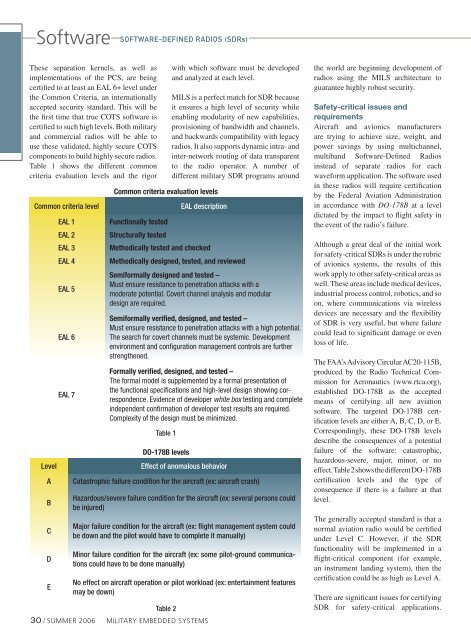Military Embedded Systems Summer 2006
Military Embedded Systems Summer 2006
Military Embedded Systems Summer 2006
You also want an ePaper? Increase the reach of your titles
YUMPU automatically turns print PDFs into web optimized ePapers that Google loves.
Software<br />
Software-Defined Radios (SDRs)<br />
These separation kernels, as well as<br />
implementations of the PCS, are being<br />
certified to at least an EAL 6+ level under<br />
the Common Criteria, an internationally<br />
accepted security standard. This will be<br />
the first time that true COTS software is<br />
certified to such high levels. Both military<br />
and commercial radios will be able to<br />
use these validated, highly secure COTS<br />
components to build highly secure radios.<br />
Table 1 shows the different common<br />
criteria evaluation levels and the rigor<br />
Common criteria level<br />
Level<br />
A<br />
B<br />
C<br />
D<br />
E<br />
EAL 1<br />
EAL 2<br />
EAL 3<br />
EAL 4<br />
EAL 5<br />
EAL 6<br />
EAL 7<br />
Common criteria evaluation levels<br />
Functionally tested<br />
Structurally tested<br />
DO-178B levels<br />
with which software must be developed<br />
and analyzed at each level.<br />
MILS is a perfect match for SDR because<br />
it ensures a high level of security while<br />
enabling modularity of new capabilities,<br />
provisioning of bandwidth and channels,<br />
and backwards compatibility with legacy<br />
radios. It also supports dynamic intra- and<br />
inter-network routing of data transparent<br />
to the radio operator. A number of<br />
different military SDR programs around<br />
Effect of anomalous behavior<br />
Catastrophic failure condition for the aircraft (ex: aircraft crash)<br />
Hazardous/severe failure condition for the aircraft (ex: several persons could<br />
be injured)<br />
Major failure condition for the aircraft (ex: flight management system could<br />
be down and the pilot would have to complete it manually)<br />
Minor failure condition for the aircraft (ex: some pilot-ground communications<br />
could have to be done manually)<br />
No effect on aircraft operation or pilot workload (ex: entertainment features<br />
may be down)<br />
Table 2<br />
EAL description<br />
Methodically tested and checked<br />
Methodically designed, tested, and reviewed<br />
Semiformally designed and tested –<br />
Must ensure resistance to penetration attacks with a<br />
moderate potential. Covert channel analysis and modular<br />
design are required.<br />
Semiformally verified, designed, and tested –<br />
Must ensure resistance to penetration attacks with a high potential.<br />
The search for covert channels must be systemic. Development<br />
environment and configuration management controls are further<br />
strengthened.<br />
Formally verified, designed, and tested –<br />
The formal model is supplemented by a formal presentation of<br />
the functional specifications and high-level design showing correspondence.<br />
Evidence of developer white box testing and complete<br />
independent confirmation of developer test results are required.<br />
Complexity of the design must be minimized.<br />
Table 1<br />
30 / SUMMER <strong>2006</strong> <strong>Military</strong> EMBEDDED SYSTEMS<br />
the world are beginning development of<br />
radios using the MILS architecture to<br />
guarantee highly robust security.<br />
Safety-critical issues and<br />
requirements<br />
Aircraft and avionics manufacturers<br />
are trying to achieve size, weight, and<br />
power savings by using multichannel,<br />
multiband Software-Defined Radios<br />
instead of separate radios for each<br />
waveform application. The software used<br />
in these radios will require certification<br />
by the Federal Aviation Administration<br />
in accordance with DO-178B at a level<br />
dictated by the impact to flight safety in<br />
the event of the radio’s failure.<br />
Although a great deal of the initial work<br />
for safety-critical SDRs is under the rubric<br />
of avionics systems, the results of this<br />
work apply to other safety-critical areas as<br />
well. These areas include medical devices,<br />
industrial process control, robotics, and so<br />
on, where communications via wireless<br />
devices are necessary and the flexibility<br />
of SDR is very useful, but where failure<br />
could lead to significant damage or even<br />
loss of life.<br />
The FAA’s Advisory Circular AC20-115B,<br />
produced by the Radio Technical Commission<br />
for Aeronautics (www.rtca.org),<br />
established DO-178B as the accepted<br />
means of certifying all new aviation<br />
software. The targeted DO-178B certification<br />
levels are either A, B, C, D, or E.<br />
Correspondingly, these DO-178B levels<br />
describe the consequences of a potential<br />
failure of the software: catastrophic,<br />
hazardous-severe, major, minor, or no<br />
effect. Table 2 shows the different DO-178B<br />
certification levels and the type of<br />
consequence if there is a failure at that<br />
level.<br />
The generally accepted standard is that a<br />
normal aviation radio would be certified<br />
under Level C. However, if the SDR<br />
functionality will be implemented in a<br />
flight-critical component (for example,<br />
an instrument landing system), then the<br />
certification could be as high as Level A.<br />
There are significant issues for certifying<br />
SDR for safety-critical applications.
















